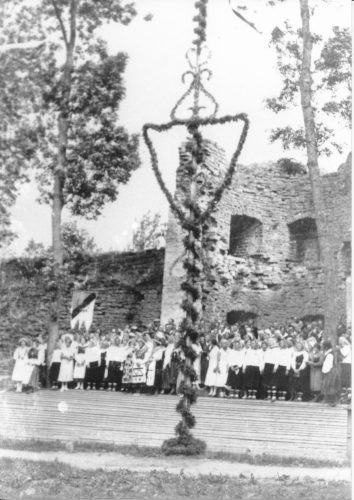The Song Festival of the Estonian Swedes
The Song Festival of the Estonian Swedes
The castle courtyard, which is the site of the open-air performance of the White Lady, has also been the venue of the Song Festival of the Estonian Swedes. The first Song Festival of the Estonian Swedes was held in the castle courtyard on 2 July 1933 with ten choirs made up of 200 Estonian Swedish singers.
The idea of a Song Festival of the Estonian Swedes was put forward by Anton Vesterberg in the newspaper Kustbon in 1926, but nothing came of it. It was only six years later that the preparations for the Song Festival began, following the example of the Swedish-speaking population of Finland. The Song Festival was seen as an opportunity to foster a sense of unity among the fragmented Estonian Swedes. The organising committee included the head of the Pürksi folk university Fr. Erlund, Helga Blees, the head of the upper secondary school Anton Üksiti, and composer and choirmaster Cyrillus Kreek, who was in charge of the repertoire and was also the general director of the festival.
The Song Festival started on 2 July 1933 with a procession of the participants to the castle courtyard. The festival itself started at 3 in the afternoon.
When everyone had taken up position on the stage, the orchestra played the national anthem. The Swedish Minister of National Affairs Nikolaus Blees was present to give a welcome speech in Estonian and Swedish. The representative of the State Elder of Estonia, Minister Zimmermann, also gave a speech. The joint choir then sang half of the repertoire.
The second part of the concert started with a performance by the summer orchestra, conducted by Juhan Simm. B. Lund, local priest, also held a speech to mark the festive event. Greetings were presented by the Mayor Dr. H. Alver, the Head of the upper secondary school Üksti, MA E. Ekroth representing the Swedish-speaking population of Finland, and Prof. Juhan Aavik from the Estonian Singers’ Association. The telegrams were read by Sven Danell. The choirs of Vormsi and Riguldi gave a separate performance.

The third part was folk dance, with performances by a joint group from the Swedish upper secondary school and the Pürksi folk university under the direction of Helga Blees, and a dance group from Pakri islands.
After the second intermission, the joint choirs took to the stage once again. In between the songs, participants were welcomed by the figurehead of the temperance movement, lecturer Oscar Olsson from Sweden, and MA Nils Tiberg reminisced about the absent Swedes from Ruhnu and Hiiumaa.
After the last choir song, member of the Riigikogu M. Westerblom thanked the choirmasters and singers on behalf of the SOV (Svenska Odlingens Vänner or Friends of Swedish Education). Everyone joined in to sing the national anthem and the singers saluted Kreek.
‘Raamat Eestimaa rootslastest’ (title in English: ‘A Book about Swedes in Estonia’) by Viktor Aman
While the festival was a huge success, it would take 80 years before the next Song Festival of the Estonian Swedes would take place. In 2013, the Estonian Swedes and their friends from Finland and Sweden once again came together in Haapsalu Castle courtyard to hold the second Song Festival of the Estonian Swedes together with a dance performance. The festival project was headed by Sofia Joonsi and the programme was closely modelled on the first festival. The third Song Festival was held in 2016, while the fourth was postponed twice and took place in August 2021 under the name ‘Aiboland, my love’. The Estonian Swedes will be singing for the fifth time in Haapsalu Castle courtyard in 2024.